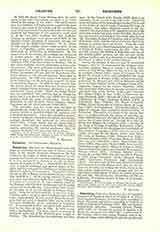

Palestrina, Diocese of (PRAENESTINENSIS); the town of Palestrina, in the province of Rome, central Italy, is the ancient Praeneste, situated on the Via Labicana, the origin of which was attributed by the ancients to Ulysses, or to another fabulous personage. It is first mentioned in history as an ally of Rome against the Latins, in 499 B.C. From 373 to 370, however, it was in continual war against Rome or her allies, and was defeated by Cincinnatus; in 354 and in 338 it lost portions of its territory. Thenceforth it was always an ally of Rome, but disdained Roman citizenship until 90 B.C. In 82, having received Marius, it was taken and sacked by Sulla; later, under Tiberius, it became a municipium. It was a summer resort of the Romans, who ridiculed the language and the rough manners of its inhabitants. The modern town is built on the ruins of the famous temple of Fortuna Primigenia. From the eleventh century, it was a fief of the Colonna, and a refuge in their rebellions against the popes; consequently, it was several times destroyed, as in 1297, by order of Boniface VIII, and in 1436, by Giovanni Vitelleschi, at the command of Eugenius IV. It was rebuilt in 1447, sacked in 1527, and occupied by the Duke of Alba, in 1556. In 1630, it was sold to the Barberini. The town contains remnants of cyclopean walls and of the aforesaid great temple of Fortune. The cathedral has fine paintings and frestoes. In the Church of St. Rosalia (1677) there is an admirable Pieta, carved in the solid rock. Palestrina is the birthplace of the archaeologist Andrea Fulvio and of the prince of sacred music, Giovanni Pierluigi da Palestrina. The oldest Christian record of this city relates to the martyrdom of St. Agapitus, patron of the cathedral, which took place under Aurelian; this, basilica was restored and enriched with costly gifts by Leo III. Secundus, Bishop of Palestrina, was at the Council of Rome (313), and the names of several other of its bishops in ancient times are known. From the sixth century there was a flourishing monastery on the site of Castel S. Pietro, overlooking the city. After the seventh century, the Bishop of Palestrina was one of the hebdomadary prelates for the services of the Lateran basilica, and was, therefore, a cardinal; he is the fourth, in order, of the cardinal-bishops. Among the prelates of this see may be mentioned Gregory, who in 757 consecrated the antipope Constantine; Andreas, legate of Adrian I to King Desiderius, in 772; Petrus (996), the first to bear the title of cardinal; Uberto (1073), legate of Gregory VII to Henry IV; Conon (1111), who embellished the crypt of St. Agapitus; S. Stefano (1122), a Cistercian monk, praised by St. Bernard and John of Salisbury for his piety; Guarino Guarini (1144), a Regular Canon of St. Augustine, famous for his virtues; Manfredo (1166) who persuaded Barbarossa to become reconciled with Alexander III; Paolo Scolari (1181), later Clement III; Blessed Guido de Pare (1196), a Cistercian; Jacopo Pecoraria (1231); Stefano III (1244), previously Archbishop of Gran; Girolamo d’Ascoli (1278), a Franciscan, later Nicholas IV; Pietro d’Anablay (1306), Grand Chancellor of France; Simon de Langham (1376), an Englishman. During the schism, the popes of Avignon, also, appointed cardinal-bishops of Palestrina. Thereafter, as a result of the custom that gave to cardinal-bishops the option of selecting another suburbicarian see, the rule of the prelates of Palestrina was of short duration. Among those who followed were Hugues de Lusignan (1431), a brother of the King of Cyprus; Guglielmo Brissonette (1507), deposed by Julius II for attending the conciliabule of Pisa; Lorenzo Campeggio (1535); Gianvicenzo Carafa (1539); Giovanni M. del Monte (1543), later Julius III; Louis de Bourbon (1550); Federico Cesi (1557); Giovanni Morone (1562); Cristoforo Madruzzi (1564); Gian Antonio Serbelloni (1578); Marcantonio Colonna (1587); Alessandro Medici (1602), later Leo XI; Guido Bentivoglio (1641); Alfonso de la Queva (1644); Antonio Barberini (1661), who founded the seminary; Paluzzo Altieri (1691); Girolamo Spinola (1775); Aurelio Rovarella (1809), who died an exile in France, in 1812; Diego Caracciolo (1814); Giuseppe Spina (1820); Castruccio Castracani degli Antelminelli (1844). The sanctuary of Our Lady of Good Counsel of Genazzano is in this diocese; here, also, are the ancient see of Gabii, ten bishops of which, between the fifth and the ninth centuries, are known, and that of Subaugusta, four bishops of which are known between 465 and 502. The diocese has 24 parishes, 45,700 inhabitants, 10 religious houses of men, 14 of women, and 3 girls’ schools.
U. BENIGNI

